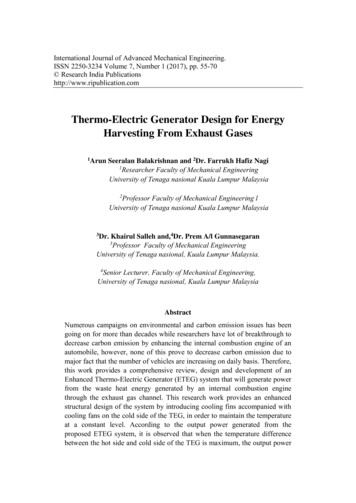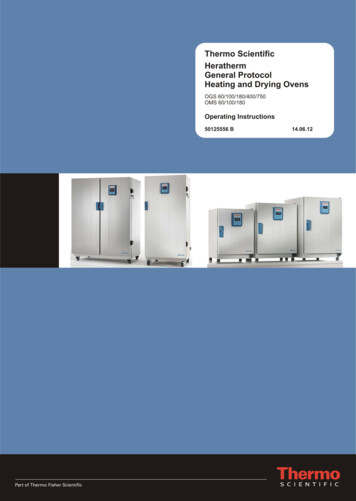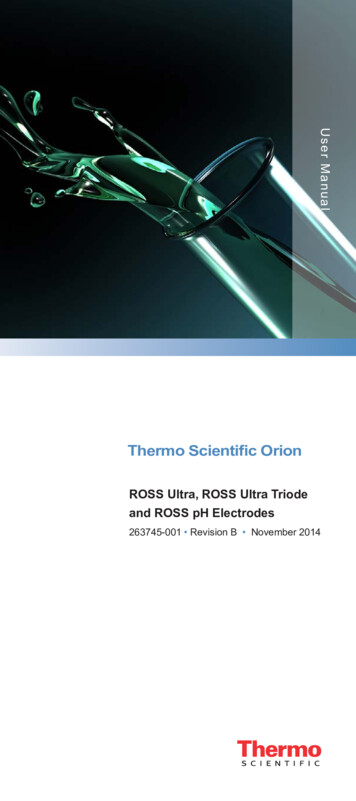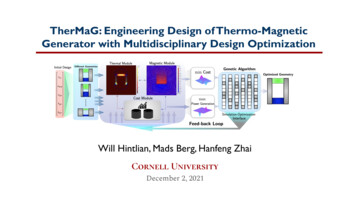
Transcription
International Journal of Advanced Mechanical Engineering.ISSN 2250-3234 Volume 7, Number 1 (2017), pp. 55-70 Research India ctric Generator Design for EnergyHarvesting From Exhaust Gases1ArunSeeralan Balakrishnan and 2Dr. Farrukh Hafiz Nagi1Researcher Faculty of Mechanical EngineeringUniversity of Tenaga nasional Kuala Lumpur Malaysia2Professor Faculty of Mechanical Engineering lUniversity of Tenaga nasional Kuala Lumpur Malaysia3Dr.Khairul Salleh and,4Dr. Prem A/l Gunnasegaran3Professor Faculty of Mechanical EngineeringUniversity of Tenaga nasional, Kuala Lumpur Malaysia.4Senior Lecturer, Faculty of Mechanical Engineering,University of Tenaga nasional, Kuala Lumpur MalaysiaAbstractNumerous campaigns on environmental and carbon emission issues has beengoing on for more than decades while researchers have lot of breakthrough todecrease carbon emission by enhancing the internal combustion engine of anautomobile, however, none of this prove to decrease carbon emission due tomajor fact that the number of vehicles are increasing on daily basis. Therefore,this work provides a comprehensive review, design and development of anEnhanced Thermo-Electric Generator (ETEG) system that will generate powerfrom the waste heat energy generated by an internal combustion enginethrough the exhaust gas channel. This research work provides an enhancedstructural design of the system by introducing cooling fins accompanied withcooling fans on the cold side of the TEG, in order to maintain the temperatureat a constant level. According to the output power generated from theproposed ETEG system, it is observed that when the temperature differencebetween the hot side and cold side of the TEG is maximum, the output power
Arun Seeralan Balakrishnan et al56generated from the system reaches the maximum. Thereby resulting in usefullow power generation from the fuel energy wasted in exhausted gases by theinternal combustion engines.Keywords: Waste heat energy, TEG, Power generation, green house effects,heat sink and Microcontroller.INTRODUCTIONMore than decades, public sectors and scientist are campaigning on environmentaland carbon emission issues, and this has brought major interest of research on internalcombustion engine, waste reduction and energy utilization. However, researchershave confirmed that internal combustion engine is considered as one of the majorconsumption fossil fuel which led to CO2 emission. In the world where 30% to 40%of heat supplied by fuel is converted into mechanical [14] while remaining heatenergy is expelled through exhaust gas pipe to the environment resulting to seriousenvironmental pollution claim to continue damaging our earth according to climatechange campaign resolution. Therefore, reduction of waste heat requires utilizationfor useful work, the utilization and recovery of waste heat will not only reduceenvironmental pollution but would also conserve fuel consumption and reduce thetotal amount of waste heat generated by combustion engine.Many researchers have carried out a lot of successful energy conversion forefficiency, however, most limit the scope of research for the improvement of thermalefficient for combustion engine, whereas, this paper focuses on potential solution tothe usage of exhaust heat resulting from internal combustion engine, exhaust gas heatrecovery system and energy utilization with increase in C02 emission yet, in costeffective way [6].The intension of this work is to provide a comprehensive review, design anddevelopment of the Thermo-Electric Generator (TEG) system to generate power fromwaste heat energy resulting by internal combustion engine through the exhaust gaschannel. [1] This is a possible solution to recover waste using thermoelectricgenerator, which will convert the temperature gradient [20] into usable voltage whichcan be used to power other appliances, such as auxiliary system and others.Proposed SystemThis research has been implemented to study about heat loss at the exhaust theautomobile engine. [21] The main objective of this research is observe the waste heatenergy that has been thrown to the atmosphere as waste. A prototype of the TEGsystem has been built and the TEGs are placed on the four sides of the Aluminumpipe line. On the top of each TEG, the Aluminum heat sink has been placed to remove
Thermo-Electric Generator Design for Enery Harvesting From Exhaust Gases57the excess heat from the cold side of the TEG. To obtain the faster rate of heat fromAluminum heat sink, the cooling fans are fixed that contributes to the heat removaland maintain the temperature on the cold side equivalent to the room temperature. Allthe four TEGs are connected in series and connected with load. The below blockdiagram (Figure 1) indicates the experiment setup.Figure 1: Block diagram of the thermoelectric generator system using heat sink andcooling fanTEG ModuleIn this research Bismuth Telluride type of thermoelectric device has been used.Below is the rated power output and selected thermoelectric device dimension. [8]This device is placed in heat environment to generate a voltage output, and also to getthe sum of a total voltage of two or more, which is connected in series and have theability to withstand a continuous high temperature 260 C (500F).Rating: Umax (V): 15.4V, Imax (A): 6A, Voltage (V): 12V, QMax (W) : 92W.Dimensions: 40mm x 40mm x 3.6mm.Concept Designed derived from fundamental principlesIn order to analyse and perform the computational data of the voltage generatormodule, some parameters have to be considered, which includes the coefficient ofSeebeck and the total amount of thermoelectric module coupled together, and thisresults to [1].N ( SeebeckCoefficentof sin glethermoe lectric sin glecouple )Where(1)
Arun Seeralan Balakrishnan et al58α: Coefficient of Seebeck of a single thermoelectric moduleN: Total number couples.Therefore, based on parameters collected from TEC1-12706 datasheet,Coefficient of Seebeck for p-type is 270μV/KCoefficient of Seebeck for n-type is -270μV/K (- sign mean n-type)Seebeck Coefficient of a thermoelectric single couple(2)total number of couples used as generator, it will now be necessary to computevoltage produced by overall combination of thermoelectric device forming a singlevoltage generator module [7](3)Where V is voltage T Is the temperature difference between T-hot and T-coldThot 60 0 c 273 3330 K(4)(5)To calculate a multiple cascade voltage of thermoelectric module(6)WhereV total is the total voltage produced, V is the produced voltage from each cascademodule and thermoelectric module number is N.[22] Considering a situation wheredevice is used for charging battery, this related to ampere hour per day, that is, therate at which the current produced is to charge a battery.Usage hours * Current flowing to the batteryFinally, output power can calculate with(7)(8)Where I and V are the total current and total voltage produced respectively.To calculate the total power which is coming out from the car, the temperature atcertain speed with specific car must be known. [4] [5] [25] the example that has beenchosen here is 1996 Dodge Caravan Sport, at speed 34mph which releases theExhaust gas (in manifold) at a temperature of 1134 which is used to convert fromFahrenheit to Celsius using the following formula:(9)
Thermo-Electric Generator Design for Enery Harvesting From Exhaust Gases59The temperature of the car exhaust is 1134 which is (612) C and it is assumed to beT(hot) and the temperature of the outside is assumed to be 35 which can called asT(cold). [15] The gas constants of the CO2 “R” is 0.1889 KJoule Kg*K taken fromthe table of ideal gas specific heats. The following formula is to calculate the internalenergy:(10)To calculate the volume flow, must chose a specific engine because each model ofengine has a different volume flow, so according to “Continental Motors Continued”the engine model that has been chosen is M330 engine under 2400rpm which is equalto 497cfm (cubic feet per minute) and after converting from cubic foot per minute tometer cube per second the volume flow will be equal to 0.2346 m3 s .According toengine “Ti-AL 605 turbo” the pressure exhausted is 144.79kpa and this pressure hasbeen taken as the average speed which is 3500rpm cross with 21psi according to thegraph of the exhaust system pressure. [17]The specific volume is obtained using the formula,(11)Further, the mass of flow of the gas can be calculated using the volumetric of flowrate over the specific volume and the volumetric flow rate can be obtained online for achosen type of car as, [9](12)Total power can be calculated by multiplying the mass of the gas flow with thedifference of temperatures as mentioned below:(13)Experimental Set upThe TEG system is set such that the four TEG modules are attached on the flat surfaceof each side of a 5cm x 5cm square hollow aluminium. Then, a cylindrical pipe of5cm is inserted through the hollow square pipe as shown in Figure 2. Furthercompression method is used in order to compress the TEG module between the heatsink and the aluminium plate, which is done with the help of stainless steel machinescrews.
Arun Seeralan Balakrishnan et al60Input of HeatEnergyFigure 2: Experimental setupFigure 3: Block Diagram of the Experimental setupFigure 4: Block Diagram of the Experimental setup with heat pipesThe above block diagram indicates that heat pipes are used in order to reduce thepower provided to the cooling fan and the excess temperature on the cold side isremoved by attaching the heat pipes to it. Each TEG module has two terminals (i.e.,red as positive and black as negative) as the generated power output. Figure 5 labelledeach part of the TEG module.Figure 5: Fully labelled TEG module
Thermo-Electric Generator Design for Enery Harvesting From Exhaust Gases61The TEG module has two sides; one of them is the hot side. [24] Actually the hot sidecan deal till 300ºC (572ºF) as maximum temperature and the hot side of the TEGshould connect to the heat source side to give the correct reading. The other side ofthe TEG module is the cold side, which can handle 60ºC (320ºF) as maximumtemperature. [18] Thus, to avoid damaging the TEG module, it is important that thehot side and the cold side temperature does not exceed these limits. In addition, if themodule has been reversed by changing the cold side and hot side positions, it willdirectly cause damage to the TEG module. [19]Figure 6 shows the wiring diagram of the four TEG modules. [23] The four modulesare connected in series to boost the overall output voltage. Then, this output isconnected to a DC-DC converter to regulate the output voltage to a desired voltage fora load.Figure 7 shows the snapshots of the constructed the final structure which consists offour TEG modules, four heat sink and four cooling FANs mounted each on the flatsurface of every side of the square hollow aluminium attached with the cylindricalpipe.Figure 6: TEG Module WiringThe constructed circuit consists of Arduino Nano soldered on the strip board belowthe LCD with the ACS712 current sensor module at the right side of the module andfinally the DC-DC converter module at the upper side of the LCD. The generatedvoltage and current are displayed on the LCD along with the temperature.
Arun Seeralan Balakrishnan et al62Input as heat energyFigure 7: Snapshot of the Constructed Circuit together with the Cylindrical TEGSystemWorking PrincipleFigure 8 presents the flowchart of the system working principle. First the systemheated is applied through the cylindrical pipe. Then, the generated current and voltagetogether with the applied heating temperature are measured through the 10-bit analogchannels 0, 1 and 2, respectively. Then, the measured value from the 10-bit analogchannel ranging between 0 – 1023 are converted to the actual reading of currentbetween 0 – 600mA, voltage between 0 – 18V and temperature between -50 C –150 C, respectively. These converted readings are then changed to string in order todisplay on the LCD.Figure 8: Flowchart of the System Working Principle.Further the Arduino IDE v1.6.9 microcontroller is programmed using the C language,which initializes the analog channel 0, 1, and 2 as input channels for current, voltageand temperature sensors. Then, initializes the LCD control signals RS and EN usingpin D13, D12 and LCD data line D4, D5, D6 and D7 using pin D11, D10, D9 and D8of the Arduino Nano. The current, voltage and temperature sensor readings are
Thermo-Electric Generator Design for Enery Harvesting From Exhaust Gases63converted using the Equations (13), (14) and (15).(13)(14)(15)RESULTS AND DISCUSSIONExperiment setup with heat sink , without cooling fan, with cooling fan under no loadcondition at constant interval of temperature at every 10 C interval ranging from40 C Figure 8 shows the graph drawn between temperature difference and voltage atno load condition with heat sink, cooling fan and without the cooling fan. It isobserved that the theoretically calculated TEGoutput voltage linearlyincreases as the temperature difference between the hot side and the cold side of theTEG increases. Further, it is observed that the experimentally measured TEG outputvoltage linearly increases until 70 degree celcius of the temperature differencebetween the hot side and the cold side, while the TEG output voltage remains almostsaturated with 3.7 v as the maximum output volatge from 80 degree celcius. Theexperimentally obtained result is varied slightly as compared to the theoretical result,which is due to the heat lost into the sorrounding atmosphere, during the conversionof the heat energy into power at the TEG system. Theoretical and experimentalcurrent is zero due to the no load condition.Figure 9: Graph between Temperature Vs Voltage (V) & Current (A).Figure 9 shows the graph drawn between temperature difference and voltage under noload condition and with the cooling fan. The cooling fan is placed on the colling fins,which is done in order to remove the excess heat that contributes to the temperature atthe cold side of the TEG. Thus, from the figure iIt is observed that the theoreticallycalculated TEG output voltage linearly increases as the temperature differencebetween the hot side and the cold side of the TEG increases. Further, it is observed
64Arun Seeralan Balakrishnan et althat the experimentally measured TEG output voltage gradually increases slowly until110 degree celcius of the temperature difference between the hot side and the coldside, and reaches a maximum output voltage of 4.7 v at 100 degree celcius. Theexperimentally obtained result is varied slightly as compared to the theoretical result,which is due to the heat lost into the sorrounding atmosphere, during the conversionof the heat energy into power at the TEG system. . Theoretical and experimentalcurrent is zero due to the no load condition.Experiment setup: with heat sink and without cooling fan but DC – DCconverterTemperature in CFigure 10: Graph between Temperature Vs Voltage (V) & Current (A).Figure 10 shows the graph drawn between temperature difference and voltage withDC-DC converter in series as the load and without the cooling fan. It is observed thatthe theoretically calculated TEG output voltage linearly increases as the temperaturedifference between the hot side and the cold side of the TEG increases. Further, it isobserved that the experimentally measured TEG output voltage linearly increasesuntil 80 degree celcius of the temperature difference between the hot side and thecold side, while the TEG output voltage remains almost saturated with 3.6 v as themaximum output volatge from 80 degree celcius. The experimentally obtained resultis varied slightly as compared to the theoretical result, which is due to the heat lostinto the sorrounding atmosphere, during the conversion of the heat energy into powerat the TEG system. Theoretical and experimental current are initially the same butdeviates a bit as the temperature difference is increased from 60 degree celcius to 110degree celcius.
Thermo-Electric Generator Design for Enery Harvesting From Exhaust Gases65Experiment setup: with heat sink, cooling fan and DC – DC converter connectedunder load conditionTemperature CFigure 11: Graph between Temperature Vs Voltage (V) & Current (A).The graph in Figure 10 shows the temperature difference and voltage with DC-DCConveter connected in series as the load and with the Aluminum fins, cooling fan.The cooling fan is placed on the cooling fins, which is done in order to remove theexcess heat that contributes to the temperature at the cold side of the TEG. Thus, fromthe figure it is observed that the theoretically calculated TEG output voltage linearlyincreases as the temperature difference between the hot side and the cold side of theTEG increases. Further, it is observed that the experimentally measured TEG outputvoltage gradually increases slowly until 110 degree celcius of the temperaturedifference between the hot side and the cold side, and reaches a maximum outputvoltage of 4.2 v at 110 degree celcius. The experimentally obtained result is variedslightly as compared to the theoretical result, which is due to the heat lost into thesorrounding atmosphere, during the conversion of the heat energy into power at theTEG system. . Theoretical and experimental current are almost follow the same as thetemperature difference is increased from 40 degree celcius to 110 degree celcius.HEAT PIPE cooling of TEGCooling TEG with fan is counter productive as the harvested output of TEG would bewasted in running the cooling fan. For further study a passive cooling device such asheat pipe is proposed to cool the TEG without any power consumption.[11]. A heatpipe is a closed evaporator-condenser system consisting of a sealed, hollow tubewhose inside walls are lined with a capillary structure or wick. Thermodynamicworking fluid, with substantial vapor pressure at the desired operating temperature,saturates the pores of the wick in a state of equilibrium between liquid and vapor.[12]
66Arun Seeralan Balakrishnan et alFigure 12: Fully labelled Heat Pipes moduleWhen heat is applied to the heat pipe, the liquid in the wick heats and evaporates. Asthe evaporating fluid fills the heat pipe hollow center, it diffuses throughout its length.Condensation of the vapor occurs wherever the temperature is even slightly belowthat of the evaporation area. [13] As it condenses, the vapor gives up the heat itacquired during evaporation. This effective high thermal conductance helps maintainnear constant temperatures along the entire length of the pipe. Attaching a heat sink toa portion of the heat pipe makes condensation take place at this point of heat transferand establishes a vapor flow pattern. Capillary action within the wick returns thecondensate to the evaporator (heat source) and completes the operating cycle.The wick structure provides a path for liquid to travel from condenser to theevaporator using capillary action. [3] Wick structures have performance advantagesand disadvantages depending on the desired characteristics of the heat sink design.Some structure have low capillary limits making them unsuitable for applicationswhere they must work without gravity assist. The heat pipes are fixed on the coldsurface of TEG to remove the excess heat energy travelling from hot side to cold sideof TEG. The analysis on heat energy transferred by using Nano fluids as the workingfluid in Heat pipes.Figure 13: Assembly of TEG with Heat Pipes moduleThis proposed system is designed to conserve fuel consumption and utilize some partof waste heat generated by combustion engine in our society. From the literture, it is
Thermo-Electric Generator Design for Enery Harvesting From Exhaust Gases67observed that the researchers have used the cooling fins to the TEG system on thecold side in order to control the temperature raise due to the power generated which isobserved to be low. Hence, in order to improve this existing system, cooling finsalong with the cooling fan, has been introduced to increase the output powergenerated and to maintain constant temperature at the cold side. Experimental resultsof different testing shows the performance of the proposed TEG system. The first testexamines the performance of the prototype without load with cooling fan OFF.Second test examines the performance of the prototype without load but with coolingfan ON. Third test examines the performance of the prototype with load but thecooling fan is OFF. Finally, Fourth test examines the performance of the prototypewith load and cooling fan ON.The results of the first test highlight that the voltage increases linearly from 40 C to80 C. The output voltage is maintained at 3.7V from 80 C to 100 C, then a suddendrop to 3.6 at 110 C. These results suggest that heating temperature of both heatingand cooling side of the TEG modules increases at the same time. This is mainlybecause in this setup, the heat sink is the only cooling components at the cold side ofthe TEG. The results of the second test highlight that the generated voltage at thecorresponding temperature. The generated voltage increases in similar to the first test,i.e., from 40 C to 70 C. While, from 80 C to 100 C the voltage increasesexponentially from 3.9V to 4.7V, respectively. Then, a slight drop of voltage from4.7V down to 4.6V at 110 C was observed. Thus, this suggests that the cooling setuphas reached its maximum point and therefore not cooling anymore the results of thethird test highlight that the generated voltage at the corresponding temperature. Thevoltage increases linearly from 0.8V to 3.6V at 40 C to 90 C, respectively. Then thevoltage drops to 3.5V at 100 C and 110 C.Results presented for the fourth test show that the current drawn by the DC-DCconverter is around 10mA with 0.8V at 40 C, and 145mA with 4.52V at 110 C. Asobserved here, the overall performance of the system is improved as the generatedvoltage is 4.2V at, which is higher than the 3.6V from Test 3. Thus, this concludesthat higher cooling power improves the temperature difference between the heat andcold surfaces. While the results of the last test show that the current drawn at 40 C bythe DC-DC converter is 10mA at 1.4V, while at 110 C is 210mA at 5.0V. Asobserved here, the overall performance of the system is further improved byincreasing the load. Thus, this suggests that the power efficiency can be improved byapplying correct amount of load to the generated power.Moreover, the theoretical performance of the TEG module used in this researchhasbeen compared with the experimental performance using the proposed system. Theseresults are based on loadconnected at the TEG output terminals. These resultshighlight that the expected voltage of the SP1848 at 20 C temperature difference is0.9V at 225mA, while the actual experimental results exhibit slightly lower. Instead,
Arun Seeralan Balakrishnan et al68the experiment shows the generated voltage at 20 C temperature difference is 0.8Vwith current drawn by the load of about 190mA.REFERENCES[1]Bianchi, M. and De Pascale, A. (2011). Bottoming cycles for electric energygeneration. Parametric investigation of available and innovative solutions forthe exploitation of low and medium temperature heat sources. AppliedEnergy.p. 1500–1509.[2]Chan, C.W., Ling-Chin, J., Roskilly and A.P. (2013). A review of chemicalheat pumps. Thermodynamic cycles and thermal energy storage technologiesfor low grade heat utilisation.p.1542-1546[3]Crane et al. (2012, May). Power Generation and Heat Recovery Using HeatPipe Thermoelectric Generator (HPTEG). (p. 211). Melbourne: Proceedings ofthe 52nd Annual Conference, Australian Solar Energy Society (AustralianSolar Council).[4]Dheeraj Kalra, Dr.Veeresh Babu A and M. Vijay Kumar. (2014). Effects ofLPG on the performance and emission characteristics of SI engine. 2(3).p.2998-3003.[5]Frobenius, F., Gaiser, G., Rusche, U., & Weller, B. (2016). ThermoelectricGenerators for the Integration into Automotive Exhaust Systems for PassengerCars and Commercial Vehicles. Journal of Electronic Materials, 1433--1440.[6]Kalra. (2014). Effects of LPG on the performance and emission characteristicsof SI engine. 2(3), 2998-3003.[7]Law, R., Harvey, A., Reay, D. (2012). Opportunities for low-grade heatrecovery in the UK food processing industry. Applied Thermal Engineering.[8]Li, K., Liu, C., and Chen (2013). Direct power generation from heat withoutmechanical work. Stanford, California Proceedings, 38th Workshop onGeothermal Reservoir Engineering Stanford University.[9]Liu, X., Deng, Y., Li, Z., & Su, C. (2015). Performance analysis of a wasteheat recovery thermoelectric generation system for automotive application.Energy Conversion and Management, 121--127.[10]Min Chen, Y. Sasaki, and R. O. Suzuki (2011) Computational Simulation ofThermoelectric Generators in Marine Power Plants. 52(8).p.1549-1552[11]Muhammad Fairuz Remeli1, Abhijit Date1, Baljit Singh1, Lippong Tan andAliakbar Akbarzadeh. (2014, May). Power Generation and Heat RecoveryUsing Heat Pipe Thermoelectric Generator (HPTEG). p. 211. Melbourne:
Thermo-Electric Generator Design for Enery Harvesting From Exhaust Gases69Proceedings of the 52nd Annual Conference, Australian Solar Energy Society(Australian Solar Council).[12]Prem Gunnasegaran et al. (2015, May). Optimization of SiO2 nanoparticlemass concentration and heat input on a loop heat pipe (HPTEG). (p. 238-250).Malaysia: Science direct Elsevier Case study in thermal Engineering.[13]Orr, B. G., & Akbarzadeh, A. (2016). Experimental testing of a car exhaustheat recovery system utilising TEGs and heat pipes. SAE-A VehicleTechnology Engineer-Journal.[14]P.R. Ubarhande and Saurabh Jagdish Sankhe. (2014). Exhaust Gas HeatRecovry System For I.C. Engine. International journal for EngineeringApplications and Technology.p. 314-322.[15]P.S.Raghavendran and R.Asokan. (2014). Operational of Health MonitoringServer in Industries. International Journal of Engineering and Technology.p.4718 - 4727.[16]Prof. Ajit Kumar Senapati, Mr. Shakti Prasad Dash and Mr. P Rakesh. (2014).Thermo-Electric Generator in Turbocharged Diesel Engine - A Review.International Journal of Innovative Science, Engineering & ammil,M.H.Hassan,S.Paria,M.Hasanuzzaman. (2012). Technologist ore cover exhaust heat from internalcombustion engines. Elsevier.p. 5049-5059.[18]Senapati, Dash and Rakesh. (2014). Thermo-Electric Generator inTurbocharged Diesel Engine - A Review. International Journal of InnovativeScience, Engineering & Technology, 276-279.[19]Sumeet Kumar,Stephen D. Heister, Xianfan Xu, James R. Salvador, andGregory P. Meisner.(2013) thermoelectric generators foe automotive wasteheat recovery systems part2: parametric evaluation and topological studies.6(2).p.125-135.[20]S.Vijaya Kumar, Amit Kumar Singh and Mohamed Farhan. (2015, May).Generation of Electricity by Using Exhaust from Bike. International Journal ofInnovative Research in Science, Engineering and Technology.4 (6).p.25112516[21]Sumeet Kumar, Stephen D. Heister, Xianfan Xu, James r., Salvador andGregory P. Meisner. (2013). Thermoelectric Generators for Automotive WasteHeat Recovery Systems Part I: Numerical Modeling and Baseline ModelAnalysis. Journal of ELECTRONIC MATERIALS.p.1-9.[22]Xiaodong Zhang, K. T. Chau, C. C. Chan, and Shuang GAO. (2010). An
70Arun Seeralan Balakrishnan et alAutomotive Thermoelectric-photovoltaic Hybrid Energy System. The 2010IEEE Vehicle Power and Propulsion Conference. pp. 1-6. Lille, France: IEEE.[23]Yu Zhou, Somnath Paul and Swarup Bhunia. (2011). Harvesting Wasted Heatin a Microprocessor Using Thermoelectric Generators: Modeling, Analysisand Measurement.p. 98-102.[24]Zhang et al. (2010). An Automotive Thermoelectric-photovoltaic HybridEnergy System. The 2010 IEEE Vehicle Power and Propulsion Conference(pp. 1-6). Lille, France: IEEE.[25]Farrukh Hafiz Nagi er al. (2016). Power Electronics Component Location andHeat Sink Length Optimization – Hybrid Electrical Vehicle (HEV) IndianJournal of Science and Technology, Vol 9(28), DOI: 10.17485.
Thermo-Electric Generator Design for Energy Harvesting From Exhaust Gases. 1Arun Seeralan Balakrishnan a. Farrukh Hafiz Nagi . nd 2Dr 1Researcher Faculty of Mechanical Engineering . University of Tenaga nasional Kuala Lumpur Malaysia . 2Professor Faculty of Mechanical Engineering l . University of Tenaga nasional Kuala Lumpur Malaysia










